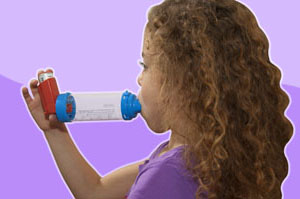Spacer/Valved Holding Chamber Access
What is a spacer & why use one?

A spacer or valved-holding chamber (VHC) attaches to the inhaler. It holds the cloud of medicine in the chamber long enough for you to inhale it in one or two slow, deep breaths. A spacer will help keep you from coughing when using an inhaler. Using a spacer/VHC with a mouthpiece is best, but if a young child or adult is unable to use one, a face mask works well.
It may seem like carrying and using a spacer/VHC is more trouble than it’s worth, but
studies show that much more of the inhaler medication gets to the lungs (known as deposition) when using a spacer than without one. Without one, it’s hard to hold the inhaler in the right place in front of your mouth, and time the squeezing of the canister with an inhaled breath. The spray often misses its target in the lungs, hitting the face, lips, tongue and back of throat.
Spacers can also help you keep from getting a yeast infection in your mouth (known as thrush) when taking inhaled steroid medicines. Children and elderly people commonly have trouble using an inhaler effectively without a spacer, but spacers can improve deposition for anyone.
View an infographic that tells why spacers are important and how to get one through a Medicaid health plan (
English) (
Spanish).
Learn how to use a spacer/valved-holding chamber.
Which inhalers need a spacer/VHC?
All quick-relief inhalers, like ProAir® and Proventil® should be used with a spacer/VHC, and many of the long-term controller medications need them, too. Which medications don’t need a spacer/VHC? Dry powder inhalers (DPIs), such as a Diskus® or Flexhaler® should not be used with a spacer, nor should the inhalers that include their own spacer, like Aerospan®.
See a full list of asthma medications.
Where can you get a spacer/VHC?

Spacers/VHCs are medical devices. Your doctor can write a prescription for a spacer to go with your inhaler and you will usually get the device at a pharmacy or durable medical equipment (DME) company. If you don’t have a prescription from your doctor for this device, you can buy them online.
If you are a member of any Michigan Medicaid health plan or are on straight Medicaid (fee for service), you can have up to 4 spacers/VHCs each year, at the pharmacy, with no prior authorization. Fee for service members can have any device that is Aerochamber® brand.
Trouble getting a spacer/VHC?
Michigan Medicaid: If you’ve tried to get a spacer/VHC at the pharmacy and the pharmacist tells you to go to a DME, have them contact the health plan. All Medicaid plans allow up to 4 spacers/VHCs each year, at the pharmacy, with no prior authorization.
Commercial insurance: If you’ve tried to get a spacer/VHC at the pharmacy and the pharmacist tells you to go to a DME to get it, call your health plan and find out if it is covered at the DME. If it is, call the DME and ask if they will mail it to you, and save you a trip to their office. They will need the doctor to send them the prescription.